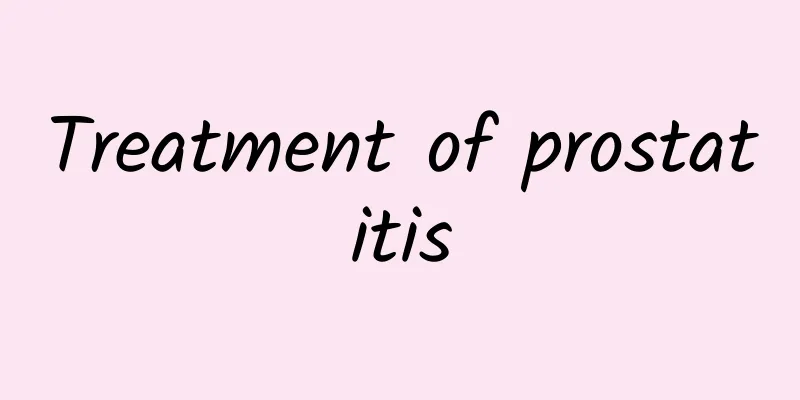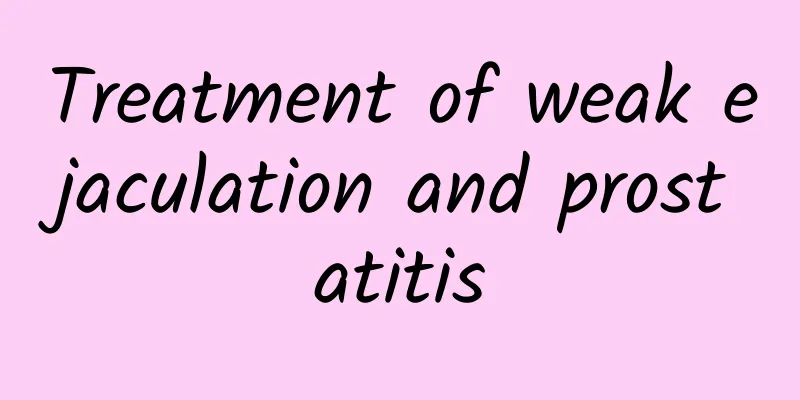Treatment of prostatitis

|
I believe that many people are familiar with the disease of prostatitis. It is mainly because we do not pay attention to our diet or malnutrition in our lives, which causes the prostate to swell and become inflamed. For the disease of prostatitis, we recommend that patients should receive timely treatment, but we should know some relevant precautions during the treatment. Prostatitis also has different situations. Friends who suffer from prostatitis must first determine what disease they have, and then treat the disease. First, a clinical assessment must be conducted to determine the type of disease, and treatment methods must be selected based on the cause. Misunderstanding the disease, unnecessary anxiety, and excessive abstinence will aggravate the symptoms. Prostatitis may be a disease with mild or no symptoms, a self-limiting disease that can be relieved on its own, or a disease with complex symptoms that leads to urinary tract infections, sexual dysfunction, infertility, etc. The discovery of pathogenic pathogens in prostatic fluid culture is the basis for selecting antibacterial drug treatment. If patients with non-bacterial prostatitis have signs of bacterial infection and general treatment is ineffective, they can also be appropriately treated with antibacterial drugs. When choosing antibacterial drugs, it is necessary to pay attention to the presence of a prostate-blood barrier composed of lipid membranes between the prostate acini and the microcirculation, which hinders the passage of water-soluble antibiotics and greatly reduces the therapeutic effect. When prostate stones are present, the stones can become a shelter for bacteria. The above factors constitute the difficulty in the treatment of chronic bacterial prostatitis, which requires a longer course of treatment and is prone to recurrence. Currently, quinolone drugs such as ofloxacin or levofloxacin are recommended. If ineffective, continue to use it for 8 weeks. If recurrence occurs and the bacterial species remains unchanged, switch to preventive doses to reduce acute attacks and relieve symptoms. If long-term use of antibiotics induces serious side effects, such as pseudomembranous colitis, diarrhea, and the growth of intestinal resistant strains, the treatment plan needs to be changed. Whether non-bacterial prostatitis is suitable for treatment with antibacterial drugs is still controversial in the clinic. Patients with "aseptic" prostatitis can also use drugs that are effective against bacteria and mycoplasmas, such as quinolones, SMZ-TMP or TMP alone, used in combination with tetracycline and quinolones or used intermittently. If antibiotic treatment is ineffective and it is confirmed to be aseptic prostatitis, antibiotic treatment should be discontinued. In addition, using a double balloon catheter to block the prostatic urethra and injecting antibiotic solution from the urethral cavity back into the prostatic duct can also achieve the purpose of treatment. Type I is mainly treated with broad-spectrum antibiotics, symptomatic treatment and supportive treatment. Type II is recommended to be treated with oral antibiotics, and sensitive drugs are selected. The course of treatment is 4-6 weeks, during which the patient should be evaluated for the efficacy. Type III can first take oral antibiotics for 2 to 4 weeks and then evaluate the efficacy. At the same time, non-steroidal anti-inflammatory drugs, α-receptor antagonists, M-receptor antagonists, etc. are used to improve urination symptoms and pain. Type IV does not require treatment. 2. Anti-inflammatory and analgesic drugs Nonsteroidal anti-inflammatory drugs can improve symptoms. Generally, indomethacin is taken orally or in suppositories. Chinese medicine also has certain effects in using anti-inflammatory, heat-clearing, detoxifying, and hardness-softening drugs. Allopurinol can reduce the concentration of uric acid in the whole body and prostatic fluid. Theoretically, as a free radical scavenger, it can also remove active oxygen components, reduce inflammation, and relieve pain. It is an optional auxiliary treatment method. 3. Physical therapy Prostate massage can empty the concentrated secretions in the prostate duct and drain the infection focus in the obstructed area of the gland. Therefore, for stubborn cases, prostate massage can be performed every 3 to 7 days while using antibiotics. A variety of physical factors are used for prostate physiotherapy, such as microwave, radio frequency, ultrashort wave, medium wave and hot water sitz bath, which are beneficial for relaxing the prostate, posterior urethral smooth muscle and pelvic floor muscle, enhancing antibacterial efficacy and relieving pain symptoms. 4.M-receptor antagonists M-receptor antagonists can be used to treat prostatitis in patients with symptoms of overactive bladder such as urgency, frequency, and nocturia but without urinary tract obstruction. 5.α-receptor antagonists Patients with prostatitis, bacterial or non-bacterial prostatitis have increased tension in the prostate, bladder neck and urethral smooth muscles. During urination, the increased pressure in the posterior urethra causes urine to flow back into the prostatic duct, which is an important cause of prostatitis, prostatic stones and bacterial prostatitis. The use of α receptor antagonists can effectively improve prostatitis and urination symptoms, which is important for preventing recurrence of infection. α receptor antagonists should be used for a longer course of treatment to allow enough time to adjust the smooth muscle function and consolidate the therapeutic effect. 6. Prostate massage and heat therapy Prostate massage is one of the traditional treatment methods. Studies have shown that proper prostate massage can promote the emptying of the prostate duct, increase local drug concentration, and thus relieve the clinical symptoms of chronic prostatitis. Heat therapy mainly uses the heat effect produced by a variety of physical means to increase blood circulation in prostate tissue, accelerate metabolism, and help to eliminate tissue edema and relieve pelvic floor muscle spasms. 7.Surgery Surgical treatment can be used for recurrent chronic bacterial prostatitis. Prostatectomy can achieve the goal of cure, but it should be used with caution. Since prostatitis usually affects the peripheral zone of the gland, it is difficult to achieve the purpose of treatment with transurethral resection of the prostate. TURP can remove prostate stones and bacterial infection lesions near the prostate ducts, which is beneficial to reduce the reinfection of peripheral zone lesions. Chronic bacterial prostatitis can lead to recurrent urinary tract infections and infertility. 8. Other treatments It includes biofeedback therapy, transperineal external shock wave therapy, psychotherapy, traditional Chinese medicine treatment, etc. No matter how many methods there are in the world, only the ones that suit you are the right ones. Friends who suffer from prostatitis, remember not to blindly seek medical treatment. You must target your own condition, understand your symptoms, combine the hospital's recommendations, and cooperate with the doctor's treatment. This is the correct way to recover. Prostatitis is not a minor illness. If you are not careful, you will regret it for the rest of your life. |
<<: The first private part of a man is actually this
>>: Symptoms of prostatic hyperplasia
Recommend
What are the symptoms of a broken wrist? How is it treated?
In the hot summer, most of the skin is exposed to...
How effective is Blood Drill Wild Oats?
Do you know what Blood Diamond Wild Oats is? It i...
My boyfriend is not feeling well and has chest tightness and vomiting blood.
Everyone's health is different. Some people d...
Causes of testicular pain after exercise
I believe everyone knows the importance of testic...
What are the treatment principles for prostate hyperplasia?
There are many types of medicines and physical th...
How many days of paternity leave does a man have?
During the period of pregnancy and delivery, men ...
How to reduce fat on the buttocks? Do one thing after meals
Men in modern society like to buy their own cars ...
What are the five big and three thick parts of a man?
Traditional big and thick It means big hands and ...
What is the cause of the pain on the right side of the man's waist?
Low back pain is a common disease. Many male frie...
What are some better medicines for strengthening the kidneys and sperm?
Kidney function is very important for men. Only w...
About freckles on boys' faces
Is it embarrassing for boys to have freckles on t...
Where is Baihui acupoint? What are the health care methods of Baihui acupoint?
In my country, when people were studying traditio...
How to diagnose penile venous leakage
Penile venous leakage refers to the symptom of da...
What happens when a man ejaculates without any semen flowing out?
In life, men suffer from many diseases due to the...
What are some ways to delay ejaculation?
Sufficient time to ensure the quality of married ...









